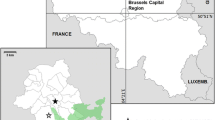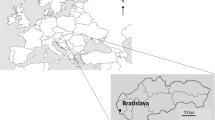Abstract
The major seasonal variations of asthma in Brisbane are significantly related to temperature (and also with dew point, for in Brisbane the curves of these two elements are almost parallel). The relation is twofold.
(1) In the six cooler months, May to October, the incidence of asthma varies directly with the temperature one to two months earlier. It is postulated that this relation depends mainly on the growth of grasses and other vegetation, which provide substrate for the growth of allergen-producing microorganisms. (2) When the mean temperature rises above 70°F (21.1°C), as from November to early April, asthma concurrently decreases, and it is postulated that above this level the final stages of allergen production are inhibited. This study suggests for further investigation (1) that decaying grass or other vegetation may be a main source of allergens and (2) that the temperature range of 60°–70°F (15.6° – 21.1°C) at which they are produced may be one guide to their identification.
Zusammenfassung
Die grösseren jahreszeitlichen Schwankungen von Asthmaanfällen in Brisbane (Queensland) sind signifikant temperatur- und feuchteabhängig. In Brisbane verlaufen die Veränderungen dieser beiden Elemente beinahe parallel. In den 6 kühleren Monaten Mai bis Oktober variiert die Asthmahäufigkeit direkt mit der Temperatur 1 bis 2 Monate früher. Es wird angenommen, dass diese Beziehung hauptsächlich vom Wachstum von Gras und anderer Vegetation abhängt, die das Material für die Entwicklung von allergen-produzierenden Mikroorganismen stellen. Wenn die mittlere Temperatur über 21,1° C zwischen November und Anfang April steigt, lässt die Asthmahäufigkeit nach. Dies liegt vermutlich daran, dass oberhalb dieser Temperatur die Endstadien der Allergenbildung gehemmt werdan. Die Annahmen, dass (a) der Zerfall von Gras und anderen Pflanzen die Hauptquelle der Allergene is und dass (b) die Temperaturzone von 15,6–21,1°C, bei der die Allergene entstehen, z u ihrer Identifizierung dienen kann, müssen durch weiteren Untersuchungen bestätigt werden.
Resume
Les variations saisonnières les plus importantes du nombre de cas d'asthme sont en corrélation significative avec la température à Brisbane (Queensland). La même relation existe également avec le point de rosée car les courbes de ces deux éléments sont presque parallèles en ce lieu. La dite relation est double: 1) durant les six mois les plus froids (de mai à octobre), les accès d'asthme sont en relation directe avec la température mesurée un à deux mois auparavant. On admet que cette relation provient en premier lieu de la croissance de l'herbe et d'autre plantes qui fournissent le substratum sur lequel se développent les microorganismes produisant les principes allergènes. 2) si la température s'élève au-dessus de 70°F (21,1°C), comme aussi entre le mois de novembre et le début d'avril (saison chaude), le nombre d'accès d'asthme diminue. On admet en effet qu'au-dessus de cette température, le stade final de prolifération des principes allergènes n'est plus atteint. On suggère d'étudier à l'avenir: 1) le pourrissement de l'herbe et d'autre plantes comme pouvant être à la source des principes allergènes et 2) la possibilité d'utiliser pour les identifier les temperatures situées entre 60 et 70°F (15,6 et 21,2°C), températures auxquelles ces principes sont produits.
Similar content being viewed by others
References
DERRICK, E.H., THATCHER, R.H. and TRAPPETT, L.G. (1960): The seasonal distribution of hospital admissions for asthma in Brisbane. Aust.Ann.Med., 9: 180–187.
GREENBURG, L., FIELD, F., REED, J.I. and ERHARDT, C.L. (1964):Asthma and temperature change. Arch.environm.Hlth., 8: 642–647.
MAUNSELL, K. (1956): The relation of particle size to the allergic reaction of the bronchi. In: The Therapy of Bronchial Asthma. W.J.Q. van Ufford (ed.), Stenfert Kroese, Leiden, p. 299.
MORRISON, I. and BATH, A.T. (1960): It happened one night. Med.J.Aust.,1: 850–852.
MOSS, J.E. (1965): Airborne pollens in Brisbane. Aust.J.Bot., 13: 23–37.
REES, R.G. (1964): The air spora of Brisbane. Aust.J.Bot., 12: 185–204.
TROMP, S.W. (1963): Bronchial asthma. In: Medical Biometeorology. Elsevier, Publ.Comp. Amsterdam, 464–476.
Author information
Authors and Affiliations
Rights and permissions
About this article
Cite this article
Derrick, E.H. The seasonal variation of asthma in Brisbane: Its relation to temperature and humidity. Int J Biometeorol 9, 239–251 (1965). https://doi.org/10.1007/BF02219956
Received:
Issue Date:
DOI: https://doi.org/10.1007/BF02219956




